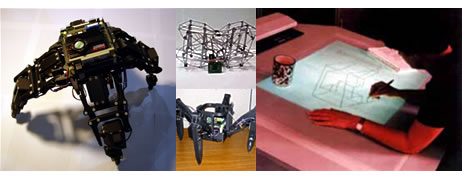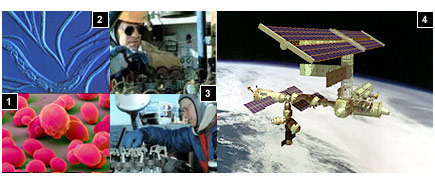

| HOME | ||
| MetaVuMaking Sense of Data |
 |
|
| ECOInfosphere |  |
|
| C-IQCollaborative Intelligence |  |
|
| NASAMission-related projects |  |
|
| BEACONBio-evolutionary Advanced Concepts |
||
| ESACEarth Science & Astrobiology Collaboratory |
 |
|
| ALifeBio-inspired Solutions |  |
|
| People | ||
| Projects | ||
| Links | ||
| HOME | ||
NASA – Mission-related projects
Proposed NASA University programs started with development of a prototype for an astrobiology program, now archived at the link above.
The concept of Biobot Mission was to develop a Petri dish to study how better to support
collaborative teams addressing cross-disciplinary bio-inspired design,
e.g. bio-inspired robotic and agent technologies and their applications, since innovation in bio-inspired technology for robotic systems will entail autonomous morphological and behavioral adaptation and evolution.
As roboticist Hod Lipson says, “The problem is Synthesis. Although we do it and teach it all the time, we lack a formal model of how this can be done automatically. Applications are numerous. This is the meta-problem of engineering: Design a machine that can design other machines.”
Here design and evolution intersect. The roboticist’s challenge is design for evolution. Lipson’s group at Cornell studies optimization and evolution — the evolution of machine design and the design consequences of biological evolution. How can step-by-step changes in a design, subject to multidimensional constraints, add functionality and improve performance via a synergistic combination of mathematics, neuroscience, robotics, mechanics, anatomy, physiology, and engineering?

| Models from
Cornell's Computational Synthesis Lab (CCSL) |
How do we supplant goal-directed actions (top down) with learning-directed actions (bottom up)? Lipson’s lab studies how self-organization and evolutionary phenomena apply to both engineering design automation and to emergent complexity in natural systems. Their aim is to harness these processes for the future of engineering.
ALife allows us to engineer systems able to adapt, reconfigure, and autonomously operate as cost-effectively as human labor. Through research on evolvable robotics Lipson and Pollack address this design challenge by what they call “robotic bootstrapping.” The task their robots must evolve themselves to perform is simple: locomotion across a flat plane. The raw materials at their disposal for self-construction are equally simple: bars and ball-and-socket joints.
Ralf Der’s lab at the University of Leipzig studies self-organizing behavior through robotic experiments. A predictive model would require the robot to be externally motivated. Der maintains that a driving force for self-organization is rooted within the agent and as a mechanistic, self-equilibrating system and that internal drive arises from spontaneous symmetry-breaking mechanisms known from the physics of self-organizing systems. These generate fluctuation amplification, a prerequisite for self-organization.
Assume that an agent is equipped with an adaptive model of its behavior, and that behavior is a by-product of satisfying the internal needs of the agent. A learning signal for both the model and the controller is derived from the misfit between the real behavior of the agent in the world predicted by its internal model. A learning signal to adapt behavior arises from its internal perspective.
Der, using simulations to study self-organizing behavior, maintains that his robotic creatures, like human children, play, which he sees as an early stage of self-organizing behavior.
Professor Christoph Adami and Charles Ofria, Director of the Digital Evolution (DEvo) Lab at Michigan State University are using digital organisms to improve our understanding of how natural evolution works in order to apply this knowledge to solving computational problems.
Jordan Pollack’s Dynamical Evolution Machine Organization (DEMO) Lab at Brandeis University explores, not only how to achieve optimization using Genetic Algorithms that accept competition as the primary motivating force, but also how to design systems that are both physically achievable and can win the economic game. Using the complex dynamics of co-evolutionary machine learning systems, he pushes the boundaries between non-life and ALife through robotic simulations of non-goal-directed evolution. He’s shown how a possible future life form could bootstrap its own evolution. He argued that we must first define life as a dynamical process, far from equilibrium, that creates a local reversal of entropy. Life dissipates energy and creates structures, which embody and transmit information. Pollack maintains that ALife is a new scientific field of critical importance to understanding life, as it has been, and as it could be, here and on other planets and inside virtual worlds.
The vehicle for this evolution is a simulation: body morphology and brain (control) evolve simultaneously. Where typically a fixed form evolves its control mechanism, or a fixed control system evolves its form, the novelty of this bio-inspired approach lies in the fact that form and control co-evolve. Bootstrapping occurs simultaneously on two levels: design of the control system and physical morphology.
Robot designers, trying to give their products enough intelligence to learn and adapt, tap the origin and evolution of life as a source of inspiration. The process of trying to design collaborative systems for ESA (the European Space Agency) and for NASA (the U.S. National Aeronautics and Space Administration) missions into space has exposed challenges that underpin synthesizing both life and intelligence. ALife’s what if? propositional approach has been a useful tool to explore how NASA might address the challenges of multi-agent missions into space — how robot teams could most effectively construct space architecture, or how sensor layouts could evolve to capture needed information from the environment.
These challenges could in turn trigger breakthrough discoveries about the origin and synthesis of life. A new research challenge is to implement behavioral adaptive autonomy in an ALife model. Such a model would show how independence complements structural coupling. It would have the capacity to generate internal constraints (its own criteria for decision-making) and to modulate its own boundary conditions. And it may provide clues to the identity of our elusive LUCA (Last Universal Common Ancestor).
Beyond the problems most readily associated with journeys into space, propulsion, navigation, food, processing waste and recycling resources, living in microgravity, establishing bases in hostile conditions, the challenges of space missions lie on the intellectual frontier of originating the life-like behaviors necessary for sending unmanned missions into space, behaviors explored in artificial life simulations.
If manned exploration is pushed forward to, say 2030, the next few decades of exploration will be undertaken by semi-intelligent, semi-autonomous creatures that we design. How will we design them? ALife explores a range of problems relevant both to the origin of life and to NASA missions into space: self-diagnosis, self-replication and self-repair (healing).
Supporting research is needed to further science and technology for life in space, from studies of life in microgravity to studies of human-robot collaboration, multi-agent tools and technology to make life in space possible.

| 1. 2. Yeast
and Nematode Worm, one of more than 10,000 known nematode
worm species, are two of the favored organisms for studies
of life in microgravity aboard the International Space Station
Laboratory. 3. Laboratory
and field experiments 4. International
Space Station (ISS) is a scientific laboratory for
carrying out experiments on life in space under microgravity
conditions. |
Further understanding of the influence of gravity on life may lead to hypotheses about how life could evolve under altered gravity conditions, such as those found on Mars or on other planetary bodies as yet undiscovered. Without gravity, life, from single cells to whole organisms, including humans, adapts, changes and responds differently to the space environment. This adaptability of life strongly influences the future of human exploration and development of space.
Today, with bioinformatics, genomics and robotic systems, biology is undergoing revolutionary changes in the information age: computational analysis, data visualization, simulation and automated processing systems that must be customized for space-based applications.